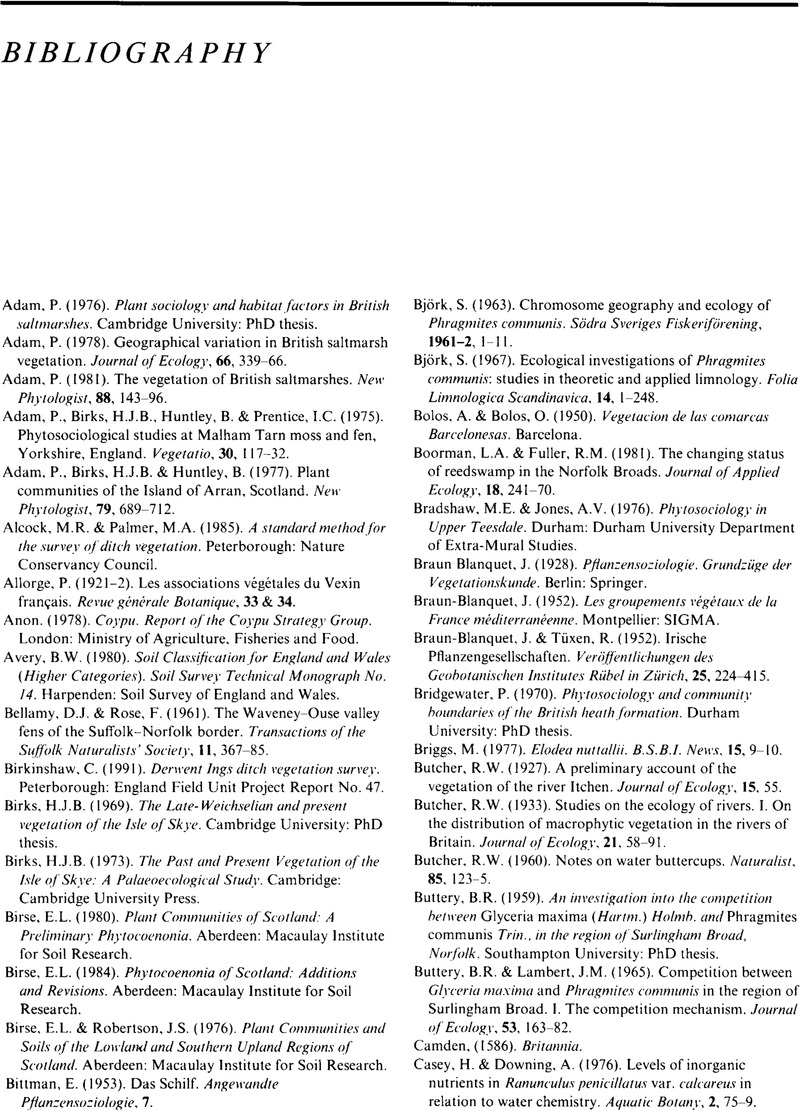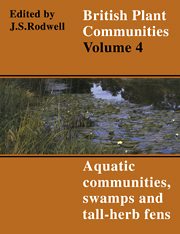Book contents
- Frontmatter
- Contents
- List of Figures
- Preface and Acknowledgements
- Preamble
- General Introduction
- Aquatic communities
- Introduction to Aquatic Communities
- Key to Aquatic Communities
- Community Descriptions
- A1 Lemna Gibba Community Lemnetum Gibbae Miyawaki & J.Tx. 1960
- A2 Lemna Minor Community Lemnetum Minoris Soo 1947
- A3 Spirodela Polyrhiza-Hydrocharis Morsus-Ranae Community
- A4 Hydrocharis Morsus-Ranae-Stratiotes Aloides Community Azolla Filiculoides in Aquatic Vegetation
- A5 Ceratophyllum Demersum Community Ceratophylletum Demersi Hild 1956
- A6 Ceratophyllum Submersum Community Ceratophylletum Submersi Den Hartog & Segal 1964
- A7 Nymphaea Alba Community Nymphaeetum Albae Oberdorfer & Mitarb. 1967
- A8 Nuphar Lutea Community
- A9 Potamogeton Natans Community
- A10 Polygonum Amphibium Community
- A11 Potamogeton Pectinatus-Myriophyllum Spicatum Community
- A12 Potamogeton Pectinatus Community
- A13 Potamogeton Perfoliatus-Myriophyllum Alterniflorum Community
- A14 Myriophyllum Alterniflorum Community Myriophylletum Alterniflori Lemée 1937
- A15 Elodea Canadensis Community Elodea Nuttallii in Aquatic Vegetation
- A16 Callitriche Stagnalis Community
- A17 Ranunculus Penicillatus Ssp. Pseudofluitans Community
- A18 Ranunculusfluitans Community Ranunculetum Fluitantis Allorge 1922
- A19 Ranunculus Aquatilis Community Ranunculetum Aquatilis Géhu 1961
- A20 Ranunculus Peltatus Community Ranunculetum Peltati Sauer 1947
- A21 Ranunculus Baudotii Community Ranunculetum Baudotii Br.-Bl. 1952
- A22 Littorella Uniflor A-Lobelia Dortmanna Community
- A23 Isoetes Lacustris/Setacea Community
- A24 Juncus Bulbosus Community
- Swamps and Tall-Herb Fens
- Introduction to Swamps and Tall-Herb Fens
- Key to Swamps and Tall-Herb Fens
- Community Descriptions
- S1 Carex Elata Swamp Caricetum Elatae Koch 1926
- S2 Cladium Mariscus Swamp and Sedge-Beds Cladietum Marisci Zobrist 1933 Emend. Pfeiffer 1961
- S3 Carex Paniculata Swamp Caricetum Paniculatae Wangerin 1916
- S4 Phragmites Australis Swamp and Reed-Beds Phragmitetum Australis (Gams 1927) Schmale 1939
- S5 Glyceria Maxima Swamp Glycerietum maximae (Nowinski 1928) Hueck 1931 Emend. Krausch 1965
- S6 Carex Riparia Swamp Caricetum Ripariae Soo 1928 157 Carex Acuta in Swamps and Fens
- S7 Carex Acutiformis Swamp Caricetum Acutiformis Sauer 1937
- S8 Scirpus Lacustris ssp. lacustris swamp Scirpetum lacustris (Allorge 1922) Chouard 1924
- S9 Carex Rostrata Swamp Caricetum Rostratae Rübel 1912
- S10 Equisetum Fluviatile Swamp Equisetetum Fluviatile Steffen 1931 Emend. Wilczek 1935
- S11 Carex Vesicaria Swamp Caricetum Vesicariae Br.-Bl. & Denis 1926
- S12 Typha Latifolia Swamp Typhetum Latifoliae Soó 1927
- S13 Typha Angustifolia Swamp Typhetum Angustifoliae Soó 1927
- S14 Sparganium Erectum Swamp Sparganietum Erecti Roll 1938
- S15 Acorus Calamus Swamp Acoretum Calami Schulz 1941
- S16 Sagittaria Sagittifolia Swamp
- S17 Carex Pseudocyperus Swamp
- S18 Carex Otrubae Swamp Caricetum Otrubae Mirza 1978
- S19 Eleocharis Palustris Swamp Eleocharitetum Palustris Schennikow 1919
- S20 Scirpus lacustris Ssp. tabernaemontani swamp Scirpetum tabernaemontani Passarge 1964
- S21 Scirpus Maritimus Swamp Scirpetum Maritimi (Br.-Bl. 1931) R.Tx. 1937
- S22 Glyceria Fluitans Water-Margin Vegetation Glycerietum Fluitantis Wilczek 1935
- S23 Other Water-Margin Vegetation Glycerio-Sparganion Br.-Bl. & Sissingh Apud Boer 1942 Emend. Segal
- S24 Phragmites Australis-Peucedanum Palustre Tell-Herb Fen Peucedano-Phragmitetum Australis Wheeler 1978 Emend.
- S25 Phragmites Australis-Eupatorium Cannabinum Tell-Herb Fen
- S26 Phragmites Australis-Urtica Dioica Tell-Herb Fen
- S27 Carex Rostrata-Potentilla Palustris Tell-Herb Fen Potentillo-Caricetum Rostratae Wheeler 1980a
- S28 Phalaris Arundinacea Tell-Herb Fen Phalaridetum Arundinaceae Libbert 1931
- Index of Synonyms to Aquatic Communities, Swamps and Tall-Herb Fens
- Index of Species in Aquatic Communities, Swamps and Tall-Herb Fens
- Bibliography
- References
Bibliography
Published online by Cambridge University Press: 04 July 2020
- Frontmatter
- Contents
- List of Figures
- Preface and Acknowledgements
- Preamble
- General Introduction
- Aquatic communities
- Introduction to Aquatic Communities
- Key to Aquatic Communities
- Community Descriptions
- A1 Lemna Gibba Community Lemnetum Gibbae Miyawaki & J.Tx. 1960
- A2 Lemna Minor Community Lemnetum Minoris Soo 1947
- A3 Spirodela Polyrhiza-Hydrocharis Morsus-Ranae Community
- A4 Hydrocharis Morsus-Ranae-Stratiotes Aloides Community Azolla Filiculoides in Aquatic Vegetation
- A5 Ceratophyllum Demersum Community Ceratophylletum Demersi Hild 1956
- A6 Ceratophyllum Submersum Community Ceratophylletum Submersi Den Hartog & Segal 1964
- A7 Nymphaea Alba Community Nymphaeetum Albae Oberdorfer & Mitarb. 1967
- A8 Nuphar Lutea Community
- A9 Potamogeton Natans Community
- A10 Polygonum Amphibium Community
- A11 Potamogeton Pectinatus-Myriophyllum Spicatum Community
- A12 Potamogeton Pectinatus Community
- A13 Potamogeton Perfoliatus-Myriophyllum Alterniflorum Community
- A14 Myriophyllum Alterniflorum Community Myriophylletum Alterniflori Lemée 1937
- A15 Elodea Canadensis Community Elodea Nuttallii in Aquatic Vegetation
- A16 Callitriche Stagnalis Community
- A17 Ranunculus Penicillatus Ssp. Pseudofluitans Community
- A18 Ranunculusfluitans Community Ranunculetum Fluitantis Allorge 1922
- A19 Ranunculus Aquatilis Community Ranunculetum Aquatilis Géhu 1961
- A20 Ranunculus Peltatus Community Ranunculetum Peltati Sauer 1947
- A21 Ranunculus Baudotii Community Ranunculetum Baudotii Br.-Bl. 1952
- A22 Littorella Uniflor A-Lobelia Dortmanna Community
- A23 Isoetes Lacustris/Setacea Community
- A24 Juncus Bulbosus Community
- Swamps and Tall-Herb Fens
- Introduction to Swamps and Tall-Herb Fens
- Key to Swamps and Tall-Herb Fens
- Community Descriptions
- S1 Carex Elata Swamp Caricetum Elatae Koch 1926
- S2 Cladium Mariscus Swamp and Sedge-Beds Cladietum Marisci Zobrist 1933 Emend. Pfeiffer 1961
- S3 Carex Paniculata Swamp Caricetum Paniculatae Wangerin 1916
- S4 Phragmites Australis Swamp and Reed-Beds Phragmitetum Australis (Gams 1927) Schmale 1939
- S5 Glyceria Maxima Swamp Glycerietum maximae (Nowinski 1928) Hueck 1931 Emend. Krausch 1965
- S6 Carex Riparia Swamp Caricetum Ripariae Soo 1928 157 Carex Acuta in Swamps and Fens
- S7 Carex Acutiformis Swamp Caricetum Acutiformis Sauer 1937
- S8 Scirpus Lacustris ssp. lacustris swamp Scirpetum lacustris (Allorge 1922) Chouard 1924
- S9 Carex Rostrata Swamp Caricetum Rostratae Rübel 1912
- S10 Equisetum Fluviatile Swamp Equisetetum Fluviatile Steffen 1931 Emend. Wilczek 1935
- S11 Carex Vesicaria Swamp Caricetum Vesicariae Br.-Bl. & Denis 1926
- S12 Typha Latifolia Swamp Typhetum Latifoliae Soó 1927
- S13 Typha Angustifolia Swamp Typhetum Angustifoliae Soó 1927
- S14 Sparganium Erectum Swamp Sparganietum Erecti Roll 1938
- S15 Acorus Calamus Swamp Acoretum Calami Schulz 1941
- S16 Sagittaria Sagittifolia Swamp
- S17 Carex Pseudocyperus Swamp
- S18 Carex Otrubae Swamp Caricetum Otrubae Mirza 1978
- S19 Eleocharis Palustris Swamp Eleocharitetum Palustris Schennikow 1919
- S20 Scirpus lacustris Ssp. tabernaemontani swamp Scirpetum tabernaemontani Passarge 1964
- S21 Scirpus Maritimus Swamp Scirpetum Maritimi (Br.-Bl. 1931) R.Tx. 1937
- S22 Glyceria Fluitans Water-Margin Vegetation Glycerietum Fluitantis Wilczek 1935
- S23 Other Water-Margin Vegetation Glycerio-Sparganion Br.-Bl. & Sissingh Apud Boer 1942 Emend. Segal
- S24 Phragmites Australis-Peucedanum Palustre Tell-Herb Fen Peucedano-Phragmitetum Australis Wheeler 1978 Emend.
- S25 Phragmites Australis-Eupatorium Cannabinum Tell-Herb Fen
- S26 Phragmites Australis-Urtica Dioica Tell-Herb Fen
- S27 Carex Rostrata-Potentilla Palustris Tell-Herb Fen Potentillo-Caricetum Rostratae Wheeler 1980a
- S28 Phalaris Arundinacea Tell-Herb Fen Phalaridetum Arundinaceae Libbert 1931
- Index of Synonyms to Aquatic Communities, Swamps and Tall-Herb Fens
- Index of Species in Aquatic Communities, Swamps and Tall-Herb Fens
- Bibliography
- References
Summary

- Type
- Chapter
- Information
- British Plant Communities , pp. 275 - 283Publisher: Cambridge University PressPrint publication year: 1995

